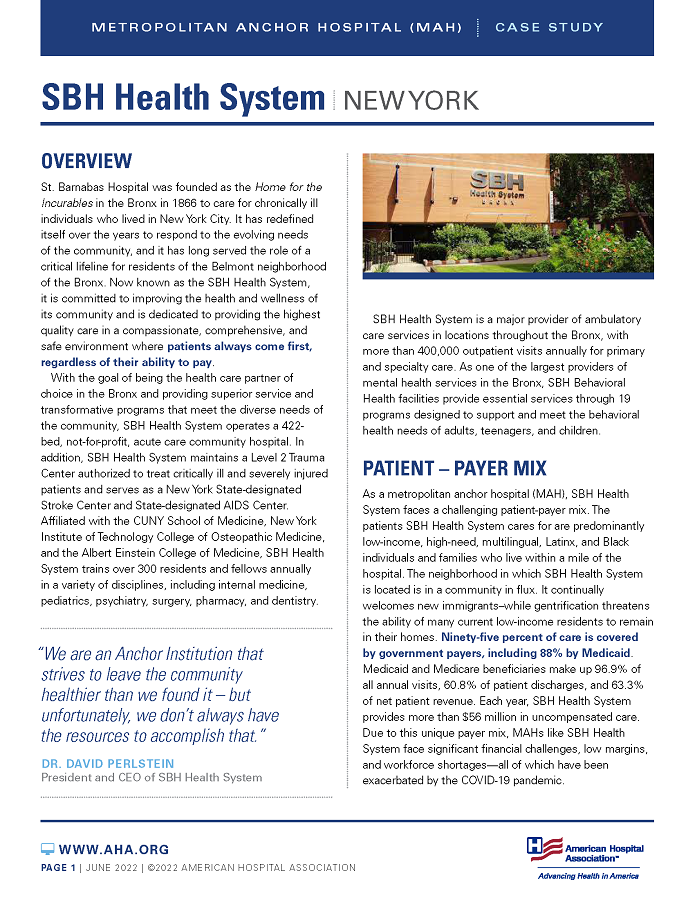

SBH Health System | New York
Metropolitan Anchor Hospital (MAH) | Case Study
Overview
 St. Barnabas Hospital was founded as the Home for the Incurables in the Bronx in 1866 to care for chronically ill individuals who lived in New York City. It has redefined itself over the years to respond to the evolving needs of the community, and it has long served the role of a critical lifeline for residents of the Belmont neighborhood of the Bronx. Now known as the SBH Health System, it is committed to improving the health and wellness of its community and is dedicated to providing the highest quality care in a compassionate, comprehensive, and safe environment where patients always come first, regardless of their ability to pay.
St. Barnabas Hospital was founded as the Home for the Incurables in the Bronx in 1866 to care for chronically ill individuals who lived in New York City. It has redefined itself over the years to respond to the evolving needs of the community, and it has long served the role of a critical lifeline for residents of the Belmont neighborhood of the Bronx. Now known as the SBH Health System, it is committed to improving the health and wellness of its community and is dedicated to providing the highest quality care in a compassionate, comprehensive, and safe environment where patients always come first, regardless of their ability to pay.
With the goal of being the health care partner of choice in the Bronx and providing superior service and transformative programs that meet the diverse needs of the community, SBH Health System operates a 422-bed, not-for-profit, acute care community hospital. In addition, SBH Health System maintains a Level 2 Trauma Center authorized to treat critically ill and severely injured patients and serves as a New York State-designated Stroke Center and State-designated AIDS Center. Affiliated with the CUNY School of Medicine, New York Institute of Technology College of Osteopathic Medicine, and the Albert Einstein College of Medicine, SBH Health System trains over 300 residents and fellows annually in a variety of disciplines, including internal medicine, pediatrics, psychiatry, surgery, pharmacy, and dentistry.
SBH Health System is a major provider of ambulatory care services in locations throughout the Bronx, with more than 400,000 outpatient visits annually for primary and specialty care. As one of the largest providers of mental health services in the Bronx, SBH Behavioral Health facilities provide essential services through 19 programs designed to support and meet the behavioral health needs of adults, teenagers, and children.
“We are an Anchor Institution that strives to leave the community healthier than we found it – but unfortunately, we don’t always have the resources to accomplish that.”
Dr. David Perlstein
President and CEO of SBH Health System
Patient–Payer Mix
As a metropolitan anchor hospital (MAH), SBH Health System faces a challenging patient-payer mix. The patients SBH Health System cares for are predominantly low-income, high-need, multilingual, Latinx, and Black individuals and families who live within a mile of the hospital. The neighborhood in which SBH Health System is located is in a community in flux. It continually welcomes new immigrants–while gentrification threatens the ability of many current low-income residents to remain in their homes. Ninety-five percent of care is covered by government payers, including 88% by Medicaid. Medicaid and Medicare beneficiaries make up 96.9% of all annual visits, 60.8% of patient discharges, and 63.3% of net patient revenue. Each year, SBH Health System provides more than $56 million in uncompensated care. Due to this unique payer mix, MAHs like SBH Health System face significant financial challenges, low margins, and workforce shortages—all of which have been exacerbated by the COVID-19 pandemic.
SBH Health System’s Unique Approach to Care
SBH Health System has a long history of working to eliminate health inequities with the limited resources it has.
Demonstrating Commitment to the Local Community
SBH Health System provides hyperlocal care in a city filled with world-class hospitals. With most of their patients living within a one-mile radius of the main facility, SBH Health System is truly a community hospital that strives to serve everyone, regardless of payment status. The system is also a bastion of the local economy. Nearly half of SBH Health System employees live in the community, of which 82% are non-white, representing the diversity of the Bronx. The system operates volunteer programs that provide a pathway to employment. For example, one employee began her SBH Health System career as a volunteer who folded baby blankets in the laundry and is now employed as a clerk in the ICU and is enrolled in a master’s degree program. During the pandemic, the system augmented its support for staff by providing groceries and PPE for their families. SBH Health System’s support for its community extends beyond the hospital doors.
Looking Beyond Urgent & Emergent Care to Address Equity
SBH Health System operates a network of outpatient departments to help address patients’ chronic health needs–including behavioral health–closer to home. In addition, the system opened a new SBH Health and Wellness Center in 2020, which includes the SBH Teaching Kitchen, a gym that is open to the community, centers for Women’s Imaging, Children’s Health and Women’s Health, a WIC site, and a rooftop farm with beehives that helps to stock a food “farmacy.” In a short time, the services have already made a measurable difference in the health and wellness of the community, and the site is serving as a “social determinants laboratory” allowing them to implement pilot projects rapidly. For example, SBH Health System is running integrated programs for individuals with obesity and type 2 diabetes, successfully helping participants decrease BMI and improve blood glucose stabilization. SBH Health System also distributes bags of produce grown on the roof-top farm to high-risk patients discharged from the hospital to ensure they have enough food in their homes. Moreover, SBH Health System maintains strong relationships with community groups to mitigate violence through trauma-informed care. For example, SBH Health System operates a Hospital Based Violence Interruption Program that combines the efforts of the emergency medicine staff with a trusted community based partner, Bronx Rises Against Gun Violence (BRAG), and runs boxing programs at their gym for girls and boys who have experienced gun violence.
Metropolitan Anchor Hospitals Need Support
Despite the financial challenges MAHs face, as well as the ongoing COVID-19 pandemic, SBH Health System is proud to have accomplished so much for its patients. But to be more impactful and adapt to a fast-changing health care landscape, MAHs like SBH Health System need adequate, sustained federal support. While SBH Health System has the potential to do even more for its community, it struggles with financial instability. To be able to continue programs and offer patients the opportunity for equitable, quality health care, additional federal resources are needed to help SBH Health System do what it does best: serve its community.
“The future of health care and the future of SBH Health System has to be in the outpatient setting and focused on keeping people healthier in order to mitigate the unnecessary emergency and inpatient admissions caused by systemic failures.”
Dr. David Perlstein
President and CEO of SBH Health System


